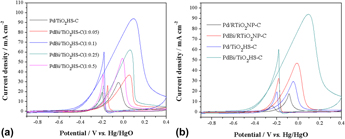Crossref Citations
This article has been cited by the following publications. This list is generated based on data provided by
Crossref.
Meduri, Kavita
Stauffer, Candice
Qian, Wen
Zietz, Otto
Barnum, Andrew
O’Brien Johnson, Graham
Fan, Dimin
Ji, Weixiao
Zhang, Changwen
Tratnyek, Paul
and
Jiao, Jun
2018.
Palladium and gold nanoparticles on carbon supports as highly efficient catalysts for effective removal of trichloroethylene.
Journal of Materials Research,
Vol. 33,
Issue. 16,
p.
2404.
Wang, Wei
Jing, Wangli
Liu, Yanqin
Wang, Yahui
Zhao, Jiao
and
Lei, Ziqiang
2018.
Supporting Pd nanoparticles on riboflavin-derived carbon: an efficient electrocatalyst for ethylene glycol oxidation.
Ionics,
Vol. 24,
Issue. 6,
p.
1745.
Mukherjee, Ayan
and
Basu, Suddhasatwa
2018.
Anion Exchange Membrane Fuel Cells.
Vol. 63,
Issue. ,
p.
105.
Liu, Xinghang
Hou, Baofei
Wang, Gang
Cui, Zhenqi
Zhu, Xiang
and
Wang, Xianbao
2018.
Black titania/graphene oxide nanocomposite films with excellent photothermal property for solar steam generation.
Journal of Materials Research,
Vol. 33,
Issue. 6,
p.
674.
Wang, Meng
Peng, Zhijian
Li, Hong
Zhao, Zengying
and
Fu, Xiuli
2018.
C fibers@MoO2 nanoparticles core–shell composite: Highly efficient solar-driven photocatalyst.
Journal of Materials Research,
Vol. 33,
Issue. 6,
p.
685.
Yang, Hui
Xie, Jian
Liu, Yingying
and
Dong, Qizhi
2022.
Rational design of PdBi nanochains with grain boundaries for enhanced ethanol oxidation reaction.
International Journal of Hydrogen Energy,
Vol. 47,
Issue. 33,
p.
14859.
Sandu, Mariya P.
Syrtanov, Maxim S.
Orlov, Sergey A.
and
Kurzina, Irina A.
2023.
Investigation of changes regularities in the valence state during the formation of supported palladium–bismuth nanoparticles using XPS.
New Journal of Chemistry,
Vol. 47,
Issue. 2,
p.
719.
Matthews, Thabo
Mbokazi, Siyabonga Patrick
Dolla, Tarekegn Heliso
Gwebu, Sandile Surprise
Mugadza, Kudzai
Raseruthe, Katlego
Sikeyi, Ludwe Luther
Adegoke, Kayode Adesina
Saliu, Oluwaseyi Damilare
Adekunle, Abolanle Saheed
Ndungu, Patrick
and
Maxakato, Nobanathi Wendy
2024.
Electrocatalyst Performances in Direct Alcohol Fuel Cells: Defect Engineering Protocols, Electrocatalytic Pathways, Key Parameters for Improvement, and Breakthroughs on the Horizon.
Small Science,
Vol. 4,
Issue. 1,
